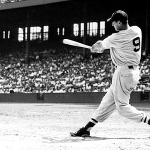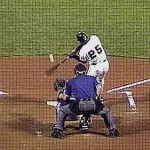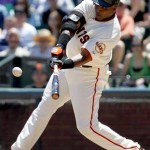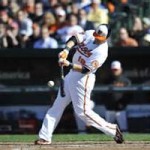“Hitting a baseball is the most difficult task to perform in all of sports.” That’s what Ted Williams once said about “batting,” the claim about which has been verified by the many expert athletes who have tested the veracity of such an arguable statement. Then why would someone have the audacity to declare that “Batting-Efficiency is a Simple Process”?
IF ITS SCIENCE IS UNDERSTOOD!
Most astute baseball observers recognize that “batting a baseball” proficiently can be esteemed as an artistic display of uncommon physical prowess. Those who demonstrate a high degree of talent in any of the various art forms could easily be described as “artists.” There is adequate evidence to indicate that many or most good artists (of which Baseball’s Bats-men are included) have a “natural” propensity toward the artisanship in which they are engaged. But their optimal level of proficiency is most often derived from the degree to which they accumulate enhanced understanding by means of scientific examination of all aspects of their chosen profession – if, for no other reason but to reduce any or all margins for error. Therefore, hitting a baseball most effectively would have to elicit from the batter’s technique a scientific component to complement his otherwise unfulfilled artistic talent. Thus the process is simple and the results are sure if the Science is understood.
BUT!
WHAT IS THE ESSENCE OF SIMPLICITY?
Einstein made E=MC2 look like a simple formula that would enlighten an ignorant, chaotic world as to the heightened prospect of infinite possibility. But that simple acronymic equation involves a seemingly endless continuum of sequential deliberation to effectuate a profitable facsimile thereof. Simplicity is the integration and coordinationof life’s infinite array of variables brought within the control of understanding. Simplicity is not the beginning of primitive evolvement, but rather the end result of organization. When chaos is changed into order, the universe (one voice) sings in simple chords of harmonious function.
The only way to describe the best of batters is that “he makes it look simple.” Look at Barry Bonds! Although it is not really simple, abiding by a strict discipline of simple mechanics, he had perfected his technique through arduous, repetitive labor, from which the human physical endeavor appeared effortless and instinctive.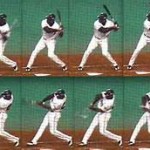
The three major components in effecting the proper technique for batting a baseball are these: balance, vision, and power. As the pitcher throws the ball, the batter’s strong balanced position allows his eyes to focus on the point where the ball is being released. Preliminary movement implies that his body is “gathering” itself to brace for any number of possible conditions. The body maintains a low center of gravity to ensure stability, while shifting its weight slightly inward (not back) to initiate a quick twisting response to the ball as it presumably enters the “zone.” The quick twisting response is effected by a rapid sequence of fluid rotary movements simultaneously by the entire turning body, beneath the stationary head. If balance and focus are maintained from start to finish, the power and effectiveness will be evident in the beauty of the “follow-through.” A batter establishes stability and balance to perform his task when his center of gravity is low. His ability to see the ball most clearly is determined by the extent to which his eyes are on a parallel level to the ball, and the degree to which the body and head maintain a stable vehicle for proper focus. Power is generated most effectively with the body in a stable, balanced position, from which all movements can be produced most speedily, and with a minimum strain to accompanying body parts. The centripetal force provided by the stable position of the vertical axis produces the powerful centrifugal force, which magnifies the power elicited by the turning hips and shoulders.
The rules are simple and orderly. To abide by them and commit them to proper interpretation are what seem to be difficult, especially to those who prefer to act on their own fallible human instincts instead of a sound basic principle. A prominent 19th century philosopher makes this statement for our consideration, “The higher false knowledge builds on the basis of evidence obtained from the physical senses, the more confusion ensues and the more certain is the downfall of its structure.” Therefore, make it SIMPLE — by letting Principle speak for itself!
The scientifically minded “artist-of-the-bat” should understand and adhere strictly to the rules of his mental-physical application, and rest his performance on this sure foundation. He should hold his thought perpetually to the idea that his natural talent and indisputable scientific certainty can and will evoke from Principle the rule for mastering the most difficult task in all of sports.
Some of my other writings include:
- My Book, The Principle of Baseball: And All There is to Know about Hitting
- Socrates and Plato: Baseball’s Wisest Fans—
- Preface—
- “Einstein and the Home-Run Principle—
- “Sit Down and Hit Properly”—
- “The Infallible Art of Hitting”—
- “The Whole Truth about Hitting”—
- “The Unsung Hero of the Proper Swing”—
- “Vision, Mechanics, and Confidence…”—
- “A Goat or a Hero—the Difference is?”—
- “Prestidigitation and Mounds-Man-Ship…”—
- Essay—“Consistency—Hallmark of a Big-League Ballplayer”—
- Essay—“Baseball’s Glory—the Continual Breaking of Records”-
- Essay—“Baseball’s Report Card” —
- Essay—“The Most Difficult Task in All of Sports” —
- Essay—“Quick Hands Did Not Sink the Titanic” —
- Essay—“The Scientific Artistry of Hitting a Baseball—
- Essay—“There’s Only One Thing Wrong With Baseball—
- Essay—“Baseball Needs a Ban on Steroids”—
- Essay—“Teamwork — Who Needs It? Who Wants It?”—
- Essay—“Hip Action — Fulcrum of Power and Speed to Swing”-
- Essay—“The Slump — Hero to Goat in No Time Flat”—
- Essay—“Success — Consequence of Progressive Thought/Action-
- Essay—“The Patient Hitter”—
- Essay—“Pitcher’s Guide…”—
- Essay—“The Greatest Errors in Baseball History”—
- Essay—“Degrees of Excellence”—
- Essay—“Consistency is not a .300 Hitter”—
- Essay—“Absolute Science of Hitting—Metaphysical Approach”—
- Essay—“Divine Comedy of Errors”—
- Essay—“Power-Hitting—Phenomenal Exhibition or Practiced Principle”—
- Essay—“Four Dimensions to Perfect Bats-man-ship”—
- Essay—“The Slump and the ‘Forgetful Hearer’”—
- Essay—“The Best that You Can Be—Perfect”—
- Essay—“Maximum Baseball Success: Can it Be Attained Selfishly?” —
- Essay—“Baseball: Becoming a Fossil in Our Midst?” –
- Essay—“Margins for Error Reduced”—
- Essay—“If not Perfection, Then What? —
- Essay—“Models of Excellence” —
- Essay—“Mysterious Realm of Consistent Batting Proficiency” —
- Essay—“Batting Efficiency is a Simple Process” —
- Essay—“Belated Farewell to a Real Legend of ‘Game’”—
- Essay—“The Complete, Clear View of Batting Proficiency”—
- Essay—“If an Absolute Principle Governs Proficient Batting…”—
- Baseball—Trilogy –
- Essay—“Baseball in Its Purist Form…” –
- Essay—“A Dreaded and Inexplicable Dilemma for a Pitcher–Barry Bonds”—
- Essay—“A Question of Faith? — An Understandable Quest!” —
- Most of the preceding can be found incorporated in the articles of my other website- posts.
